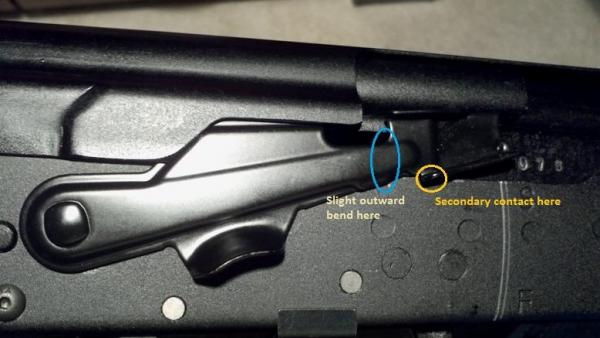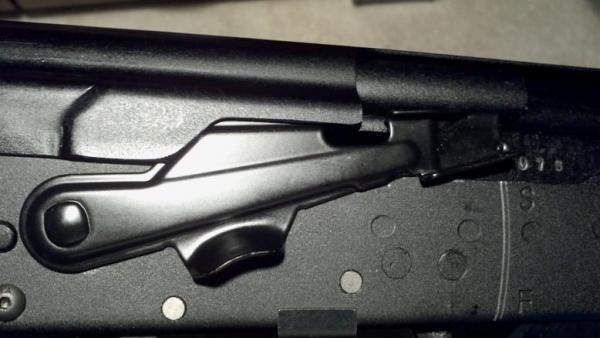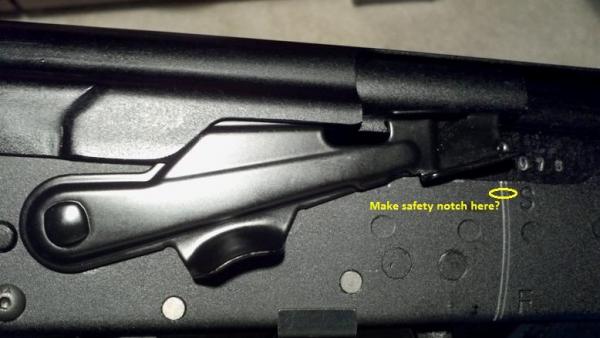-
Content Count
21 -
Joined
-
Last visited
Content Type
Profiles
Forums
Gallery
Blogs
Calendar
Store
Posts posted by true.believer
-
-
BigChris, that was my original question (with respect to the "Safe" position, specifically).
-
If you have the dust cover off, you can force the safety selector to disengage via pull of the trigger, but it should take a lot of pull (i.e. more than the weight of the firearm with fully loaded magazine). The dust cover doubles as the final stopping mechanism for the travel in the safety selector. The first rule in performing any type of functional check, inspection, part removal (of any kind), etc. is to unload and clear the firearm. As long as you do that, and have the dust cover installed during live fire operation, you will have no issues with the safety disengaging (assuming proper FCG installation, which from your description sounds like is the case).
-
That sounds like a good idea; I think the small bevel alone will make a pretty significant reduction in that "spring action" out of the selector travel once it reaches the top of the receiver. On back end of the "head" of the selector there is a slight protrusion that makes secondary contact with the receiver that provide the tension contact against the receiver once the primary dimple passes the edge of the receiver. This secondary contact has a pretty pronounced edge on it, that catches above the upper edge of the receiver once the selector begins to over-travels; this looks like it adds another "spring action" to the selector movement, causing it to over-travel further, and is also the culprit in the difficulty of returning the selector to the "Fire" position.
So I think by giving a very slight outward bend to the "head" of the selector, and maybe even very slightly grinding and polishing the edge of the protrusion at the secondary contact (to give it a smoother sloped edge rather than the "hard" edge) would significantly relieve the transition headaches that I am currently having.
Nephilim7, I don't recall off-hand there being anything on the factory disconnect that acted as an over-travel stop for the selector; but I'll take a look at it and see if I can find something on that front.
-
Compared to the Saiga rifles, the primary dust cover on the shotgun receivers have a longer notch on side with the charging handle to allow for clearance of the ejected shells. The problem that I have seen with this is that the safety selector, when pushed upward to the "Safe" position, frequently travels well beyond the top of the receiver, only stopping after it begins to set underneath the dust cover. This can make it rather awkward and difficult to move the safety into the "Fire" position, even with a modified safety selector (like the Krebs Mark VI-S).
I am thinking that possibly adding a safety selector-stop notch at the "Safe" position would help to prevent this over-travel and reduce the difficulty in transitioning back to the "Fire" position, approximately in the location shown here:
I don't see any issue with the selector position at this notch location that would cause problems with keeping the fire control mechanism locked, and it appears that the selector position is still sufficiently in-line to prevent charging the bolt. Has anyone tried this before, and/or are there any potential problems that I am overlooking with this seemingly innocuous modification?
-
That is sick! And your video production on that ad turned out very nice; I especially liked you music choice--it has me amped up!
-
 1
1
-
-
This is outstanding news! The innovation that you are breathing into the Saiga/AK industry is truly monumental and exciting!
-
 1
1
-
-
There is only ever two--master and apprentice. And now that the master is gone, it is time for the apprentice to take the throne

-
 2
2
-
-
I would start here: http://forum.saiga-12.com/index.php?/topic/13312-picture-post-lets-see-your-saiga-12/
It is a pinned thread in the Saiga-12 sub-forum where lots of members have loaded up pics of their converted/modified/personalized Saigas.
Here is the link to the same topic in the 7.62x39mm sub-forum: http://forum.saiga-12.com/index.php?/topic/13290-picture-postlets-see-your-762x39/
-
Here is a link to an article on the ATF website that summarize/describes firearms included in NFA registration.
http://www.atf.gov/publications/download/p/atf-p-5320-8/atf-p-5320-8-chapter-2.pdf
In short for a shotgun, if the barrel (including any permanently attached muzzle device, which is qualified in the above article) is under 18" in length or if the overall shotgun is less than 26" (i.e. back of receiver to front of the barrel), then it is subject to NFA registration.
With respect to the Saiga shotguns, there are some issues with how much gas is passed through the gas ports back to the bolt cycling action when you shorten the barrel (the pressure gradient is affected, so some changes to the gas port size and/or possible the piston are needed)...I won't even pretend to know any of the detail of how to tune this, but there are some exceptionally knowledgeable and skilled people in the business community that have "perfected" this (Tony at Tromix and Jack at JT Engineering come to mind, but there are several others). If you do want to shorten the barrel any from the factory configuration (I think that the standard barrel lengths coming from the factory are either 19" or 24"), I would recommend using one of these business members to do the work so that you get the best results.
-
Looks so industrial...so efficient.....so cold. Would make mother Russia proud.
-
 2
2
-
-
I believe that Cobra 76 two was working on this for a while several years ago and had some quite functional prototypes. I seem to recall that he was on the verge of setting them up for production but I never heard what happened with them (I was absent from the forum for a couple of years). You might hit him up and see if he has info to pass along.
-
-
The list of options on all of the Tromix 12ga shotguns list a SRTrigger as an available upgrade for $85. What exactly is the SRTrigger?
-
I posted these questions in the Tech Section several days ago but have not received a single response, so I'm re-posting here in case the people in the know have missed it. Surely somebody on this board has some type of experience with replacing the gas block and front sight block!
A few questions regarding replacing the front sight block and gas block on the IZ-132 7.62x39 Saiga.
1.) When replacing the stock gas block with the Romanian AK-022 gas block (from K-VAR...http://www.k-var.com/shop/product.php?prod...=292&page=1), or any gas block for that matter, how does one go about assuring that the gas ports are aligned between the barrel and the new gas block?
2.) Are there any jigs or clamping methods (or any other tricks of the trade) to help maintain proper alignment of the gas block and front sight block (such as the AK-333 FSB...http://www.k-var.com/shop/product.php?prod...=290&page=1) while the retainer pin holes are being drilled out through the blocks and barrel?
3.) Since the retainer pin locations for the AK-022 gas block and the AK-333 FSB are in entirely different locations than the retainer pin locations for the stock gas block and FSB, are there any reliable methods to fill-in the old retainer pin holes on the barrel?
-
Is there not a single person here who has any experience or knowledge about the gas block or front sight base?

-
A few questions regarding replacing the front sight block and gas block on the IZ-132 7.62x39 Saiga.
1.) When replacing the stock gas block with the Romanian AK-022 gas block (from K-VAR...http://www.k-var.com/shop/product.php?prod...=292&page=1), how does one go about assuring that the gas ports are aligned between the barrel and the new gas block?
2.) Are there any jigs or clamping methods (or any other tricks of the trade) to help maintain proper alignment of the gas block and front sight block (such as the AK-333 FSB...http://www.k-var.com/shop/product.php?prod...=290&page=1) while the retainer pin holes are being drilled out through the blocks and barrel?
3.) Since the retainer pin locations for the AK-022 gas block and the AK-333 FSB are in entirely different locations than the retainer pin locations for the stock gas block and FSB, are there any reliable methods to fill-in the old retainer pin holes on the barrel?
-
The general rule I like to follow is assume that you will always use foreign-made high capacity magazines and covert enough of the other parts on the 922® list reach at least the 10 total foreign parts. This way you can use either U.S.-made or foreign-made mags with no worries (and this is great as many times the foreign-made mags are much cheaper).
There is tons of excellent information on this forum as well as a very straightforward guide at http://www.cross-conn.com/Saiga_Conversion/ on how to replace enough of these parts to achieve this goal.
-
Are there any plans to make the .30Cal rifle shark brakes avaiable again? The S-12 shark brake is just so wickedly awesome I can't imagine building a Saiga AK without one of these on it!
-
I've seen several AK buttstocks that state they must be used with either milled or stamped receivers--if one uses the ACE internal receiver block, does that limit the choice of buttstocks to one or the other, or can both milled and stamped receiver buttstocks work?
Once you install your ACE receiver block on your milled or stamped AK, any stock or accessory that attaches to it can be used.
They make receiver blocks for both types of receiver.
I only see one type of internal receiver block on the ACE website, and I don't see that it specifies anywhere whether it is for milled or stamped receivers. I have read elsewhere on this forum that people have used this on their Saigas, which is what I would like to do. I'm not sure what the difference is between a milled or a stamped receiver, nor which one the Saiga 7.62x39 is considered to be.
-
I've seen several AK buttstocks that state they must be used with either milled or stamped receivers--if one uses the ACE internal receiver block, does that limit the choice of buttstocks to one or the other, or can both milled and stamped receiver buttstocks work?






Are there any concerns with making a notch for safety selector stop?
in Saiga-12
Posted
Tromix makes this bezel spot on the top edge of the receiver. Here is an example that I was able to find: